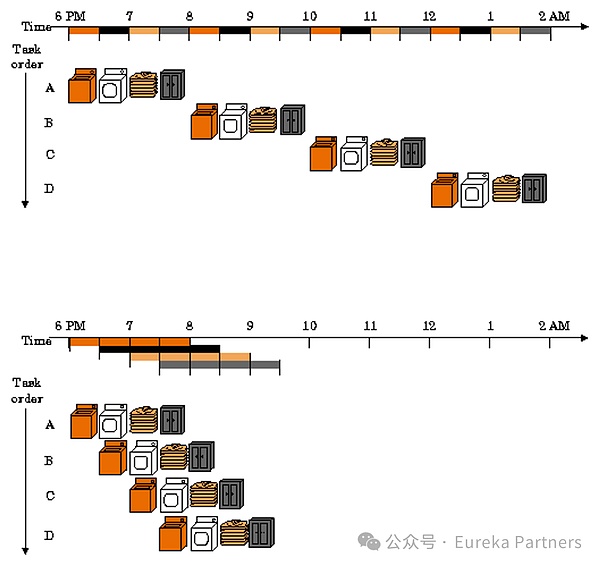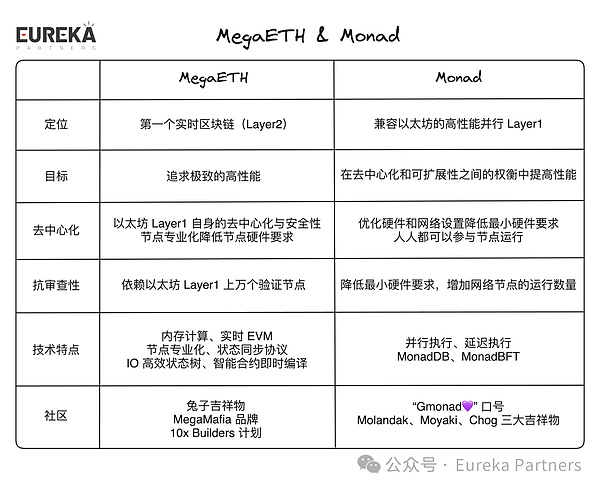Foreword
In the recent Blankless broadcast about MegaETH vs Monad (https://www.youtube.com/watch?v=1qZbLyHPErg), the discussion between Lei Yang and Keone Hon has sparked widespread heated discussions, and the definition of Full node has attracted countless media discussions.
This article will sort out the ins and outs of MegaETH vs Monad, and introduce and analyze them respectively and give opinions on them.

MegaETH vs Monad
The discussion of MegaETH and Monad in the podcast mainly revolves around the similarities and differences between the two, how to achieve decentralization and anti-censorship, and the definition of Full Node.
Similarities and differences between MegaETH and Monad
Speaking of the similarities between MegaETH and Monad, the first is that the original intention of the two is the same - high-performance public chain. They both believe that the current Ethereum Layer1 processing 10-15 transactions per second has long been unable to meet the performance requirements of the current industry, but EVM has undergone long-term market verification and has become an important standard in the industry. Although the current EVM may be lacking in some aspects such as performance bottlenecks, there is no fundamental flaw. Over time, continuous improvements to the EVM will make it better, which is why both choose to build on the EVM.
The differences between MegaETH and Monad are mainly reflected in the following two aspects:
Different goals: MegaETH pursues extreme high performance; Monad aims to obtain maximum performance from minimal hardware requirements while ensuring decentralization as much as possible.
Different architectures: Based on the above goals, MegaETH conducted research on all current Layer1 and Layer2, and finally found that it was impossible to achieve extreme high performance and balance performance and decentralization in Layer1, so it chose to build MegaETH on ETH Layer2 and perform partial optimization; while Monad resolutely chose to build a Layer1 on its own and optimize it at different structural levels such as database, efficiency, execution, and algorithm while ensuring decentralization to the greatest extent.
Decentralized implementation and anti-censorship
Before realizing high-performance public chains, MegaETH and Monad both considered how to do this while ensuring decentralization.
From the specific implementation method, Monad optimizes the hardware and network settings to achieve the minimum hardware requirements, so that everyone can easily run the node, thereby achieving decentralization. This is mainly because Monad believes that the original Ethereum network has high operating requirements. Monad wants to directly optimize various structures in the network so that lower-end consumer-grade hardware can also run, lower the threshold for user participation, and realize Vitalik's ideal of "everyone can run a node".
MegaETH optimizes performance and reduces users' hardware costs by splitting the responsibilities of full nodes into different roles. Traditional full nodes need to perform multiple tasks in the blockchain network, such as state synchronization, transaction sorting and execution, so the hardware requirements are high and many ordinary users cannot afford it. However, MegaETH splits these tasks into three roles: sorter, prover, and full node, and each role is only responsible for specific tasks. This division reduces the burden on individual nodes and reduces the requirements for hardware, allowing everyone to run nodes and improve decentralization. MegaETH has also optimized computing and state reading and writing, further improving performance. At the same time, the decentralization of MegaETH mainly relies on the existing decentralized foundation of Ethereum Layer1, because Ethereum itself has tens of thousands of full nodes and is highly decentralized.
By contrast, Monad has a stronger belief in pursuing decentralization, and all improvements and optimizations need to ensure sufficient decentralization; MegaETH believes that decentralization is only one of its characteristics, so it chooses to rely on the market-proven security of Ethereum Layer1 as a guarantee, and it will focus more on how to improve performance.
In general, Monad optimizes the underlying structure of the blockchain network, while MegaETH reasonably allocates the hardware requirements for node operation and optimizes the existing execution, communication and other aspects of the network.
In this discussion topic, Lei also repeatedly mentioned the term anti-censorship, which means that transactions and data on a blockchain cannot be easily reviewed, manipulated or suppressed by any single party. In this respect, MegaETH and Monad are also quite different. Although MegaETH uses a single active sorter to execute and verify all transactions in the entire network, it relies on tens of thousands of verification nodes in Ethereum Layer1 to ensure the network's anti-censorship; while Monad ensures the network's anti-censorship by lowering the threshold for node operation and increasing the number of network nodes.
Full Node Definition
In the process of discussing the question of "who is more decentralized", Lei and Keone have different opinions on the definition of Full Node. The reason for the disagreement is mainly that everyone expresses different starting points.
The full node mentioned by Lei of MegaETH refers to the full node role in the system after MegaETH decouples and splits the full node role. Its main responsibility is to synchronize the latest state copy of the system, but it is not responsible for executing all transactions in the system. The full node mentioned by Keone of Monad refers to the broad definition of full node, that is, a node that can access all states and execute all transactions. Because everyone did not know in advance that MegaETH had made the improvement of node splitting, ambiguity arose.
Introduction and Analysis of MegaETH and Monad
As emerging representatives of high-performance public chains, this section will introduce and analyze the technical characteristics, community culture, advantages and disadvantages of the two to help readers better understand the positioning and development direction of these two major projects.
MegaETH: Improving Performance through Node Specialization
In terms of technical characteristics, one of the core innovations of MegaETH is to professionally split the responsibilities of traditional full nodes, which is called node specialization. Typically, full nodes undertake multiple tasks, including state synchronization, transaction sorting, execution, etc., resulting in high hardware requirements and hindering the participation of ordinary users. MegaETH divides nodes into three categories: sorters, provers, and full nodes, each with its own responsibilities, thereby significantly reducing hardware requirements and improving overall performance. In addition, MegaETH has introduced a series of optimization technologies to further improve the efficiency of computing and state processing: Real-time EVM engine: MegaETH introduces the first real-time EVM execution engine, which can quickly process a large number of transactions when they arrive and reliably publish state changes (state diff) in intervals as short as 10 milliseconds. Smart contract just-in-time compilation: Using just-in-time compilation (JIT) technology, smart contracts are dynamically converted into native machine code, eliminating the inefficient process of interpreting EVM bytecode. This technology can improve the performance of computationally intensive applications by up to 100 times, and is suitable for building complex DApps with high real-time performance requirements.
State tree improvement: MegaETH replaces the traditional Merkle Patricia Trie (MPT) with a new state tree, which greatly reduces disk I/O operations and solves the performance bottleneck in state tree maintenance. This new design not only maintains EVM compatibility, but also efficiently expands to TB-level state data.
State synchronization protocol: MegaETH uses an efficient point-to-point protocol to propagate state updates from the sorter to the full node with low latency and high throughput. Even nodes with poor network connections can keep the latest state synchronized at an update rate of 100,000 TPS.
In terms of community culture, MegaETH pays attention to its community culture construction. Rabbits, as its mascot image, frequently appear in various community activities, and related cultural shirts, hats and other peripheral products also create a sense of belonging for community members. In addition, MegaETH has incubated a brand called MegaMafia, which aims to provide support to developers and ecosystem builders, helping them build projects on MegaETH or design ecosystem peripherals. In order to motivate developers, MegaETH launched the 10x Builders program to promote high-performance projects to be built on its platform.
Therefore, MegaETH has the following three advantages:
Node specialization: Effective allocation of hardware resources, reducing the pressure on individual nodes and lowering the hardware entry threshold.
Relying on the security and anti-censorship of Ethereum Layer1: MegaETH maintains the decentralization and anti-censorship characteristics of Ethereum, while focusing on the performance optimization of Layer2, achieving a balance between performance and security.
Focus on developer experience: Encourage developers to participate in ecosystem construction through various tools and ecological plans, and lower the threshold for user participation.
However, it should be noted that MegaETH has a potential security risk, that is, its network relies on a single active sorter to verify transactions. Although a certain security guarantee is provided through optimistic Rollup and economic models, it is essentially a trust assumption, which may affect the decentralization and security of the system in extreme cases.
Monad: Breaking through the limitations of Ethereum architecture
The core technical highlight of Monad lies in its deep optimization of blockchain architecture. By introducing the following four major technical innovations, the transaction processing efficiency has been greatly improved. Consumer-grade hardware can also participate in the operation of network nodes, significantly reducing the participation threshold, making the Monad ecosystem more open and popular:
Parallel execution: That is, the original transaction execution is to execute the next transaction after a complete transaction is completed. Monad achieves parallel processing by dividing the task into a series of smaller tasks that can be processed in parallel, and can also solve the problems of state storage, transaction processing and distributed consensus in the transaction processing process. As shown in the figure below, when washing four pieces of clothing, the simplest strategy is to wash, dry, fold and store the first piece of clothing first, and then start the second piece of clothing. The parallel mechanism of Monad is to start washing the second piece of clothing when the first piece of clothing enters the dryer.

Image source: https://docs.monad.xyz/technical-discussion/concepts/pipelining
MonadBFT: Simply understood as the above-mentioned consensus mechanism for parallel execution, it is more efficient than the traditional Byzantine consensus mechanism.
Delayed execution: The traditional transaction on-chain process is 1) the node first completes the transaction execution 2) the verification node reaches consensus on the transaction on the chain. The performance bottleneck in this process is mainly in the execution part. Delayed execution can verify and then execute the transaction within a certain time range, greatly improving the efficiency of transaction on-chain.
MonadDB: Innovate the database used by most Ethereum clients to improve state access efficiency to better support parallel execution of transactions.
The Monad community should not be ignored either. The three mascots, unique community slogans and Meme culture have formed a distinctive brand image. Unlike other projects, Monad does not rely on task platforms or testnet nodes for marketing, but interacts with users through a variety of community activities, creative competitions and mini-games.
Therefore, Monad has the following three advantages:
Break through the bottleneck of Ethereum architecture: Monad is not limited to the original design of Ethereum. While maintaining EVM compatibility, it can perform underlying optimizations so that consumer-grade hardware can also participate in the network.
EVM compatibility: Monad can directly use the existing EVM ecosystem to help developers migrate and build DApps more easily.
High community activity: Monad has accumulated a group of loyal community users, and a good community culture provides a solid foundation for ecological development.
However, the current number of Monad verification nodes is still small compared to the number of Ethereum nodes, about 200-300. Over time, large-scale expansion may pose new challenges to its parallel processing capabilities and network consistency. When the number of nodes increases further, whether Monad can continue to maintain its high performance and how effective its performance improvement is remain to be verified.

Summary and Evaluation
MegaETH and Monad each promote the optimization and development of blockchain networks through different paths. MegaETH maintains the decentralized foundation of Ethereum through node specialization and optimization of the existing architecture, and achieves significant performance improvements. Monad optimizes the underlying architecture while ensuring decentralization, reduces the hardware threshold, and provides the community with an efficient development experience.
Therefore, Eureka Partners believes that it is not possible to make a hasty conclusion about which one is stronger between MegaETH and Monad. First, the two have different perspectives. MegaETH pursues extreme performance, while Monad is committed to maintaining decentralization and lowering the user threshold. Second, the two have completely different routes. MegaETH is Layer2, while Monad is Layer1.
But one thing is certain: the high-performance public chain track they pursue will be one of the future development trends of the industry. The current infrastructure has been criticized for its low efficiency and high cost, and it has restricted the entry of many DApps with high-frequency interaction needs. The arrival and improvement of high-performance public chains in the future will gradually make up for this shortcoming and make the entire industry ecosystem more prosperous.
 JinseFinance
JinseFinance
 JinseFinance
JinseFinance Kikyo
Kikyo Coinlive
Coinlive  Catherine
Catherine Catherine
Catherine Others
Others Beincrypto
Beincrypto Coindesk
Coindesk Catherine
Catherine Nell
Nell